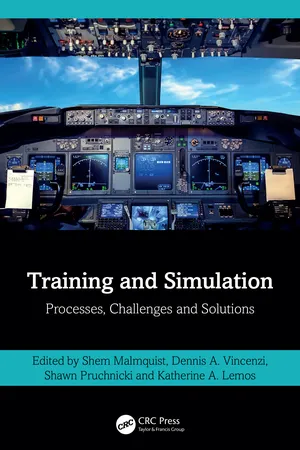
Training and Simulation
Processes, Challenges and Solutions
- English
- ePUB (mobile friendly)
- Available on iOS & Android
Training and Simulation
Processes, Challenges and Solutions
About this book
Developing training and simulation is a complex business. From understanding human performance design, usability and the limitations of training types to considerations with virtual reality (VR), producing realistic scenarios and even helping accident investigations leaves the practitioner with almost an overwhelming challenge. However, they know that their goal is to cut out developing methods that can train and test the sharp-end professional to be ready for any eventuality whether in the air, a chemical plant or the operating room. Through chapters written by leading experts, this book aims to address the key questions and concerns when developing training and simulation in high-risk industries.
This book identifies unexplored challenges and weaknesses in the aviation domain, including ground-based training and flight simulation compared to the real world of in-flight complex aircraft operations, aviation accidents and incidents, airspace and air traffic control, aeronautical communications, air navigation, aircraft automation, and pilot certification and testing.
These concerns are not just relevant to aviation, however. This book pushes beyond aviation to include other fields, including petrochemical and medicine, that, while on the surface are different, include some of the same human and organizational challenges.
It integrates machine challenges with human factors science and includes a view of the corporate influences on training. Safety is a consideration in all the challenges and current limitations in training and simulation, and the book is written with the intention of improving both training and safety as industries deal with more and more complex advanced technology.
Underpinned by case studies and real-life examples, this book will give the reader a thorough overview of the limitations of current training methods but with a view to improving and developing better methods for future training scenarios. Opportunities and solutions are presented for current or future research and the application and incorporation of these in day-day operations.
Training and Simulation: Processes, Challenges and Solutions will appeal to practitioners of human factors, training, pilots and ground operators, engineers involved in systems design, safety specialists, test evaluators, and accident investigators across multiple domains.
Frequently asked questions
- Essential is ideal for learners and professionals who enjoy exploring a wide range of subjects. Access the Essential Library with 800,000+ trusted titles and best-sellers across business, personal growth, and the humanities. Includes unlimited reading time and Standard Read Aloud voice.
- Complete: Perfect for advanced learners and researchers needing full, unrestricted access. Unlock 1.4M+ books across hundreds of subjects, including academic and specialized titles. The Complete Plan also includes advanced features like Premium Read Aloud and Research Assistant.
Please note we cannot support devices running on iOS 13 and Android 7 or earlier. Learn more about using the app.
Information
Table of contents
- Cover Page
- Half Title page
- Title Page
- Copyright Page
- Contents
- Preface
- Editor Biography
- Contributors
- 1 Realism in Simulation
- 2 Do Pilots Alter Their Decision-Making in the Simulator?
- 3 The Problem with Motion Drive
- 4 Scenarios, Simulation, and Simplicity: Coming Together for Improved Pilot Training
- 5 Training and Simulation: Enhancing Military Readiness
- 6 Challenges in the Future of Aviation
- 7 Airline Pilot Training with Consumer Technology: Evolution and Challenges
- 8 Limitations of Data-based Training
- 9 The Airline Pilot (A True Story)
- 10 Pilot Training: Impact on Aviation Safety
- 11 What Is the Point?
- 12 Validity and Reliability of Flight Crew Training and Testing: A Regulatory View
- 13 Speaking the Same Safety Language: The Chemical Industry Needs a Common Taxonomy
- 14 New Frontiers in Cybernetics for Training and Human-Systems Optimization
- 15 Culture and Performance
- 16 Investigating the Role of Socio-Technical Factors, with an Emphasis on Training, in Causing Incidents Using the AcciMap Framework: Cases from the Oil and Gas and Healthcare Industries
- 17 Differences Between Simulation for Training and Simulation for Evaluation/Assessment
- Index